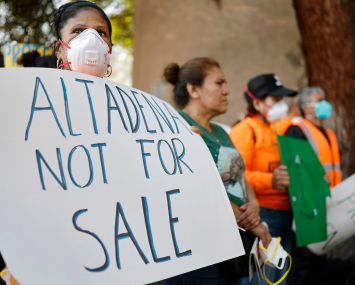Green and Wellness Certifications Are Big Business. But Are They Worth It?
For customer-facing businesses, certifications can add a branding boost
By Anna Staropoli March 6, 2024 12:30 pm
reprints
The hilltop spa at the Inns of Aurora overlooking upstate New York’s scenic Cayuga Lake is the picture of rest and relaxation. For the Inns’ visitors, however, it’s what’s on the inside that counts. As guests head from the spa’s art-adorned entrance to its grazing cafe and plunge pools, they pass a plaque that’s subtle in placement but direct in meaning: “WELL GOLD 2022,” it says, marking the spa as the country’s first to meet the criteria.
“When a consumer sees a WELL seal on the door or a WELL plaque in the lobby, it serves as a kind of shorthand that signals that the organization has put them first and is deploying strategies to help keep them and their families safe and well,” Rachel Hodgdon, president and CEO of the International WELL Building Institute, told Commercial Observer via email.
Third-party certifications and rating systems — which focus on the likes of wellness, sustainability and even internet connectivity — have come to characterize buildings of all kinds, including customer-facing businesses. Whether it’s a spa in the Finger Lakes or a microbrewery in the Midwest, businesses across the country have turned to certifications to enhance their image — and their value.
The value of these rating systems, however, depends on the nature of the real estate, as well as the business in question. Many commercial real estate owners and investors have already recognized the financial value of these goalposts, because in both a post-pandemic and ever-warming world tenants of everything from offices to apartment complexes want to inhabit safe, energy-efficient buildings that cut carbon and costs without cutting corners.
According to a 2022 National Association of Realtors report, 41 percent of real estate agents correlated green-certified buildings with an increase in commercial property values. Likewise, per Massachusetts Institute of Technology researchers, certified healthy buildings tend to see a 4.4 to 7.7 percent rent increase relative to proximal ones that aren’t certified. It follows, then, that it’s often in an owner or landlord’s best financial interests to set their sights on certification and make the changes a given label entails.
Yet for owner-occupier real estate the motivation for a given certification is less straightforward, though no less meaningful. Incentives to fulfill building performance levels vary from company to company, but ultimately circle back to impact. A certification can build up a brand, tangibly improve the quality of a given building, and appeal to both customers and employees who value wellness and sustainability.
Trust and transparency
In the current climate, it shouldn’t come as a surprise that customers are increasingly conscious of the spaces they inhabit. Owners of all property types — from commercial properties to schools, senior housing and government buildings — have prioritized health. The number of buildings certified by WELL or Fitwel increased roughly ninefold from 2017 to 2020, according to a Global Wellness Institute report.
“There hasn’t been a time in working memory when the average consumer had this level of heightened awareness about the impact of the places where they frequent — where they live their lives — on their health, well-being and safety,” said Hodgdon. “The pandemic, the mounting human impacts of climate change [and] the proliferation of random senseless violence have forced us to come to terms with the fact that we never know what’s around the corner.”
This increased awareness has materialized in better building practices, as well as greater transparency. Prospective tenants want to know how a given building operates in terms of impact, efficiency and resilience. Clients of global architecture and design firm Gensler, for example, are asking for climate risk assessments to better understand how buildings will operate in both the current climate and a future one, said Anthony Brower, a Los Angeles-based global climate action and sustainability leader and senior associate at Gensler.
Without an outward-facing mission, “brands don’t even know how many customers they’re losing,” said Brower, who noted that potential customers do their own research, which can be as simple as checking a company’s website. “A lot of times it’s not our client that we’re trying to service; it’s our client’s clients.”
A client’s clients — or customers — look for businesses they can trust, and certifications provide a reason. Brower likened people who seek out certified buildings to those who select a clothing brand based on a company’s best practices and manufacturing habits. There’s a difference between advertising building practices and actually earning a certification, which introduces an element of tangibility.
That’s been the case for the LEED-Silver certified hospitality brand Level Seattle. “Achieving certification has provided us with competitive advantage — whether it be with companies seeking hotel partners that align with their corporate values, or attracting leisure guests who prefer to stay in environmentally responsible accommodations,” general manager Ryan MacDonald told CO via email.
Some building performance certifications may simply review documentation provided by a business, whereas others dig into the specifics. Back in upstate New York, a WELL inspector visited the Inns of Aurora’s spa to examine everything the Inns claimed in its application and take physical samples of the air and water, said Laura Coburn, the resort’s director of serenity, who undertook the WELL application process.
It all comes down to proving your sustainability and health claims, said Brower. “[Customers are] getting really savvy to the greenwashing that happens in the industry.”
Build back better
However transparent a business may be, the exact impact of a certification depends on the nature of the company. A wellness achievement is more relevant to a spa or wellness center like the Inns of Aurora, whereas an office building may benefit from an energy efficiency certification, as customers care more about reducing operating costs. Meanwhile, for tourist-driven resorts, such as international brand Club Med, eco-certifications from BREEAM or an equivalent location-relevant standard does the job.
In Grand Rapids, Mich., the LEED green building rating system comes with particular name recognition. Grand Rapids boasts the country’s first LEED-certified food market and YMCA, among other unique properties, and once contained the most LEED-certified buildings per capita. (Now, Washington, D.C., outranks it.) Some other firsts include the Grand Rapids Art Museum which ranks as the world’s first LEED Gold art museum, the Rapid Central Station and commercial microbrewery Brewery Vivant.
“We knew [LEED] would be a thing that the community would understand when we talk about sustainability,” said Kris Spaulding, owner of Brewery Vivant, which achieved LEED Silver in 2012. “Here’s proof that we mean it.”
The brewery achieved that ranking through a variety of efforts. It captures rainwater runoff in a cistern and releases it gradually into the ground, uses high-efficiency heating and cooling units with carbon dioxide sensors, and saves water with low-flow toilets and sinks that rely on sensors, among other efforts.
However, the nature and size of the building proved a limiting factor that kept Brewery Vivant at the Silver level. Spaulding went the renovation route, transforming Vivant from a funeral parlor into a Belgian-style microbrewery. Despite its status as a historic building, the brewery was considered new construction; its structure was intact, but Spaulding had to redo the building’s “guts,” installing new HVAC, electric and plumbing systems.
“Now there’s a ton of breweries that are certified,” said Spaulding, who admits that Brewery Vivant missed some of the points necessary for LEED Gold or Platinum. “We missed almost all the energy points because our system is small and we can’t recirculate any of the energy.”
For comparison, breweries with larger systems like Sierra Nevada’s North Carolina location can better manage their energy footprint, said Spaulding. The brewery’s facility in Mills River, N.C., earned LEED Platinum, becoming the country’s first production brewery to achieve the highest level.
LEED levels range from Certified to Platinum, and use a points-based system. Buildings can earn a rating by focusing on water, energy, transportation, materials and more. They can therefore tailor their LEED efforts toward their choice of efforts and rack up points strategically. The Certified level begins with a 40-point baseline, whereas Platinum starts at 80.
Like LEED, WELL similarly invites brand recognition, but not without requiring businesses to put in the work. At the Inns of Aurora, the spa’s air filtration occurs at a faster rate than most hospitals in the United States, said Alex Schloop, the Inns’ creative director and director of marketing. The Inns has also focused on improving the quality of light and air, and the ability to adjust personal comfort through temperature, along with other facets of wellness.
These factors collectively contribute to that WELL certification, though WELL Gold wasn’t the Inns of Aurora’s original aim. Rather, the certification mindset came about naturally during the spa’s construction, which began prior to the pandemic. The spa’s architecture team happened to include a member of the International WELL Building Institute Board, who was familiar with the certification’s standards for thinking about the built environment.
“[The architect] approached us to say, ‘Your building is already 85 percent of the way there in terms of all of the things you need to do,’” said Schloop. “Why not take that a step further and really commit to this idea of caring for the regular inhabitants?”
Caring for those inhabitants is easier said than done, as WELL’s following tends to consist largely of commercial real estate owners and operators rather than spas. (Granted, more than 5 billion square feet of real estate uses WELL, including organizations of all sizes across sectors, per Hodgdon.)
“A lot of the [WELL application] language felt like I should be applying for a mixed-use high-rise in New York,” said Coburn, “Because it’s like: Do you have a fresh market in your lobby, or a cafe?”
To combat some of these challenges, Coburn reinterpreted some criteria and entered into a dialogue with WELL, in which she petitioned for a different pathway specific to the nature of the spa. The entire application process took roughly one year and forced the spa to be well rounded from the ground up. “Every area, I felt, was just as weighted as the next,” said Coburn of the application. “The nutritional component was just as arduous as the communication component, the air quality component.”
Employee environments
Third-party building certifications neatly package and verify a business’s values and thereby appeal to a specific customer demographic. They also, importantly, cater to the employees who frequent a building.
“[The value is] a little more subtle in that it makes an impact on the guests because, in general … the people that work here are happy,” said Coburn. The Inns of Aurora staff feels cared for within the building, she said. Their noticeable contentment, in turn, impacts how guests experience the resort.
Research spurred by WELL and LEED, among other certification companies, backs up these assessments, suggesting an increase in workplace satisfaction. For instance, a 2022 study in the journal Building and Environment showed a roughly 30 percent increase in workplace satisfaction, as well as a 26 percent increase in well-being scores and a 10 percent increase in occupant mental health in WELL-certified buildings. (Some of the researchers were affiliated with and funded by WELL.)
“[WELL is] basically certifying that this building is in support of the health of its regular occupants,” said Coburn. “What I love about the WELL certification is it literally brought me to a place of thinking about: How can every aspect of this building bring wellness to the people who are regularly inhabiting it?”


